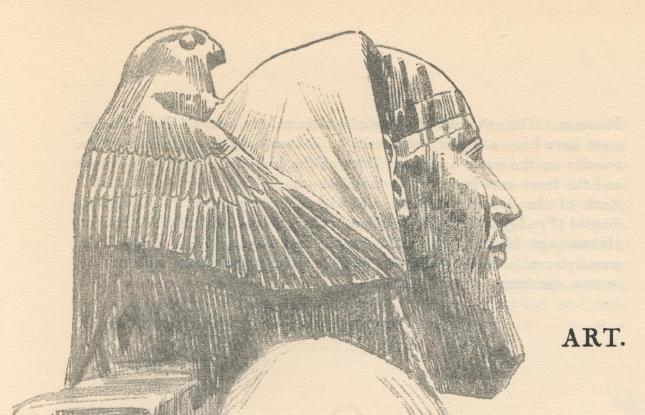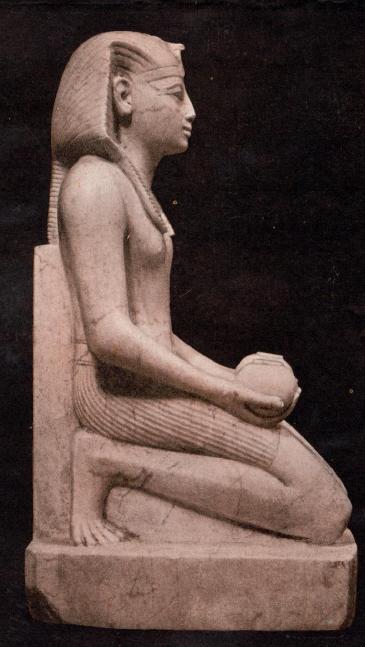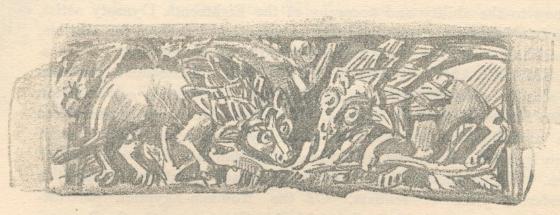
"Egypt", writes Sir Denison Ross, "is the cradle of the arts, and were
it not for the survival of so many of her early monuments the opening chapters
of the history of Art would be largely based on conjecture"" her archives
are the oldest
The love of beauty runs as a shining vein through the long history of Egypt. It may be, as many contend, that the noblest works of Egyptian Art are the statues and carvings of the early Dynasties, and particularly from the third to the tenth Dynasty. But right through the ages of Egypt beauty was always sought and often attained. Of the Pre-Dynastic periods much has been discovered in the past thirty or forty years. The earliest statuettes, primitive reproductions of the human figure, are made of clay and their interest is historic rather than artistic. But of the same distant period -more than 3000 years before the present era -there is the magnificent basalt figure now in the Ashmolean Museum. The features are expressive, the technical skill very great indeed. With the advent of the Dynastic Period the art of Egypt underwent a complete transformation. Highly artistic work, full of character, action and anatomical detail suddenly replaced the crude and clumsy representations of former centuries. An early example is the statue of an ape, inscribed with the name of King Narmer, and now in the Berlin Museum. The unknown sculptor of a slate palette, also of King Narmer, must have been a perfect anatomist as is shown by the precision of the muscles on the outer and inner sides of the leg, the grip of the left arm and the tense muscle upholding the right arm. Each of the five periods into which Ancient Egyptian Art is usually divided (Pre-Dynastic, Old Kingdom, Intermediate and Middle Kingdom, Hyksos and New Kingdom, Ptolemaic and Roman), has a wealth of masterpieces. In this brief sketch it is only proposed to indicate one or two specimens of each period.  MIDDLE KINGDOM: A new style in relief work arose with the XIth Dynasty, full of delicate variety in the surfaces and of elaborated close-packed lines of hair and ornaments. Freedom from conventional restraint is also characteristic of this period and both these factors are illustrated by the relief adorning the limestone sarcophagus of the Princess Kawit at Deir el Bahari. The Princess is depicted taking refreshment from a cup ordered by a waiting maid while another maid dresses her hair. Of the statues a good example is that of Amenemhat III.  0f the grace, the intimacy of the art of this period modern excavations have yielded a wealth of examples for it comprises the reign of Tutankhamen, whose tomb is the greatest of modern archaeological discoveries. Many artists have visited Egypt with the sole object of seeing the admirable work found in the tomb of Tutankhamen. Nearly all of them agree that, as Mr. Howard Carter, the discoverer, himself writes "hardly any specimen surpasses the magnificent gold mask from the head of the king's mummy". An eye-witness of the opening of the tomb is quoted as saying "Those who were privileged to see the actual face (of the mummy) when finally exposed can be testimony to the ability and accuracy of the Eighteenth Dynasty artist... who had so faithAfully represented the features, and left them for all time in imperishable metal, a beautiful portrait of the young king. PTOLEMAIC AND ROMAN PERIODS.Subsequent centuries show, alas I a gradual
decline in Egyptian art. Convention and tradition acted as fetters on artistic
impulse. Yet there are many masterpieces of this period which, did they
not suffer by comparison with those of previous generations, would still
place Egyptian art on a pedestal to its own. The green basalt head of an
old man, found at Memphis, is a wonderful piece of realism. Of the Romano-Egyptian
portraitstatues the most remarkable is that of Julius Caesar now in the
Baracco Collection at Rome.
 Coincidently with the reawakening of many other talents and activities the past twenty years have also witnessed a veritable renaissance of Egyptian art. One of its earliest manifestations is, appropriately enough, a statue entitled "The awakening of Egypt" which, the work of an Egyptian sculptor Mukhtar, stands in one of the main squares of Cairo.- The work of Egyptian painters has, in a short space of time, gained wide appreciation in foreign countries as well as .in Egypt. With the passage of time, with the improved technique which the Fine
Arts Department of the Egyptian Government does its utmost to foster, there
can be little doubt that Egypt, the home of art, will rapidly regain her
place among the artist nations of the world.
|